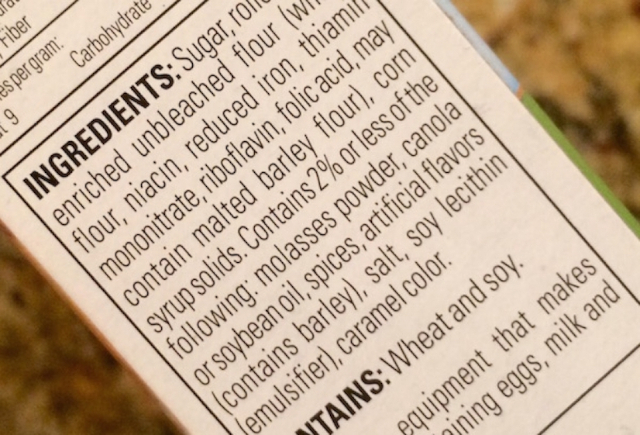This blog has repeatedly lamented the use of ‘Shrinkflation’ by many different food manufacturers. It’s a means of keeping prices more or less in line by reducing the amount of product in a standard package. Now ‘Skimpflation’ is front and centre…
 A commercial baked goods ingredients label. The rule of thumb is, the longer the list,
A commercial baked goods ingredients label. The rule of thumb is, the longer the list,
the less healthy the product may be. Such labels may also help consumers
trying to identify Skimpflated products. On second thought? Why
not take a few minutes to make your own cookies?
UK consumers polled on the quality of common, every-day grocery products had a lot of negative comments on a new trend: Skimpflation.
The phenomenon is described as the lowering of the quality of products while keeping the price the same – or, in some cases, raising it.
Across-the-board examples
A survey comissioned by Barclay’s Bank last month found across-the-board consumer dissatisfaction with the general decline in quality of their favourite products:
- 52 percent of Britons perceived an overall a downgrade in the quality of ingredients in their favourite products.
Of those:
- 44 percent reported a change in the quality of crisp [salty snack] products
- 43 percent had seen the same for sweets and chocolate
- 36 percent thought their favourite cakes or biscuits were inferior to those they had bought before
- 22 percent said takeaways [takeout foods] are decreasing in quality, and
- 20 percent thought the same of restaurant meals
In all cases, ‘skimped’ products showed no decrease in price.
Not limited to food
- 41 percent of consumers said they have noticed skimpflation on products other than food and drink
- 44 percent believed the quality of clothing is falling, and
- 37 percent reported the quality of toiletries and cosmetics has dropped.
Shrinkflation compounds Skimpflation
Shrinkflation, which first made food news headlines a few months ago, continues to be front of mind for 84 percent of UK shoppers. Chocolate, salty snacks and biscuits [cookies] remain the products most commonly identified as being affected.
This adds up to a double whammy on shoppers. They’re getting less. And what they’re getting is of lesser quality. At the same time, the price is staying the same as before, or rising.
Skimpflation ‘invisible’
Which.co.uk styles itself as ‘the UK’s consumer champion‘: “As an organisation we’re not for profit and all for protecting consumers – a powerful force for good, here to make life simpler, fairer and safer for everyone.”
Which? retail editor Ele Clark notes: “Shoppers might spot a smaller pack size or higher price before they get to the till, but they’re unlikely to notice a recipe change until they’ve bought the product and sampled it.
“Quietly altering recipes to cut costs at a time when many people have a lot less to spend won’t help rebuild dwindling trust in the food sector. So it’s important that manufacturers and supermarkets are upfront about changes to popular products. That way customers can make an informed choice.”
My take
Skimpflation is even more insidious than Shrinkflation – as Ele Clark points out. And it’s obvious that it ‘won’t help rebuild dwindling trust in the food sector’.
When did food product marketing switch from a cooperative business model to an adversarial one? Would it not be much better in the long run – as Clark suggests – for food product manufacturers to be ‘more upfront about changes’?
I can see Skimpflation plus Shrinkflation combining to make consumers angry enough to change brand allegiances to makers who aren’t trying to pull the wool over their eyes. The problem is… All the major manufacturers are probably doing it.
*SIGH*
~ Maggie J.

